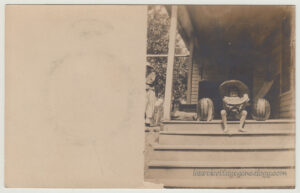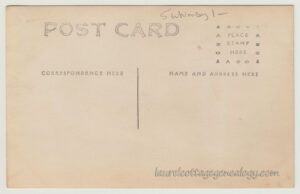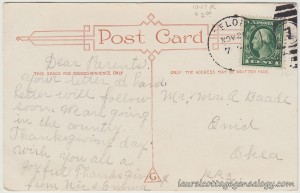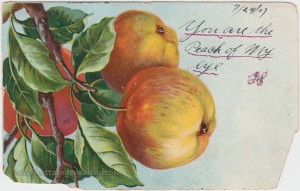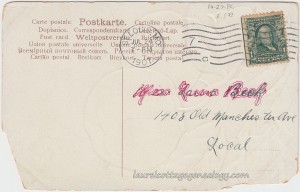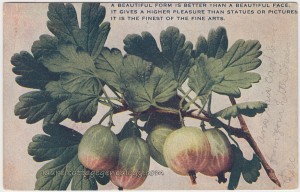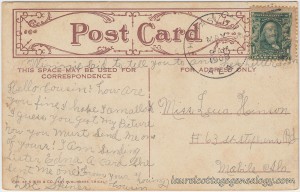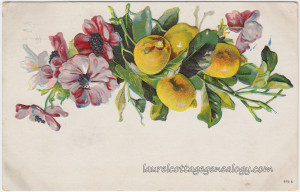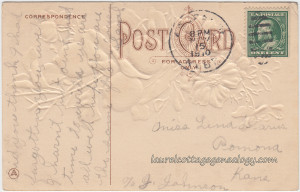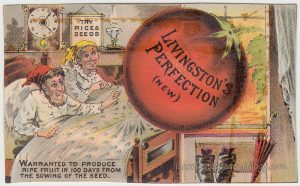
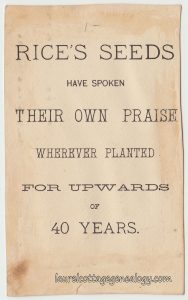
Trade card for Rice’s Seeds. Circa 1880 – 1881.
Price: $12.00 Size: 4 and 1/2 x 2 and 5/8″
“Livingston’s Perfection (New). Warranted to produce ripe fruit in 100 days from the sowing of the seed.”
“Rice’s Seeds have spoken their own praise wherever planted for upwards of 40 years.”
Here’s a beauty (and incidentally sorry to say we missed a Memorial Day post due to working on another project and then running out of time and energy. Poor time management, alas! Next year, though.) But this beauty of a trade card shows an older couple, in their nightgowns and nightcaps, being awoken, to their joy, by a giant tomato, ripened to perfection, that has overflowed from the garden through their open window.
We find mention of Livingston’s Perfection, as early as 1881 and as late as 1918, in trade journals, so from this info and the word “new” in parentheses on the card’s tomato, one might infer both the card and, of course, the variety, to have emerged in 1881, or maybe 1880.
Who was Livingston?
From “Pomodoro!: A History of the Tomato in Italy”:
“In Ohio between 1870 and 1893, Alexander Livingston, developed or improved thirteen major varieties for the tomato trade. He named most of them after himself, such as ‘Livingston’s Marvel’, ‘Livingston’s Magnus’, ‘Livingston’s Paragon’, and ‘Livingston’s Perfection.’ Some of these varieties eventually found their way to Parma, Italy, suited as they were to the production of concentrate.”
And Rice?
Rice was Jerome Bonaparte Rice, born in Salem, New York, July 19, 1841, son of Roswell Niles Rice and Betsy Ann (Hodges) Rice. He became hugely successful in the seed business which was started by his father around 1834 – selling seeds via wagon, which the younger Rice returned to, after coming home from the Civil War. A few other tidbits of information: J. B.’s capture by the Confederate Army and imprisonment at Libby and Belle Isle led to rheumatism (no wonder) which later confined him to a wheelchair. He was “the father” of the Cambridge Valley Agricultural Society – the president of the Cambridge, New York fair, as shown in the illustrated ad below, and the 3-story mansion (which included a beautifully ornate “birdcage” style elevator) that he and his wife built (1902 – 1904) in Cambridge. The home had stood vacant in recent years, but was thankfully restored starting in 2004 and today serves as a historic inn currently available for group reservations. See Rice Mansion Inn. J. B. Rice died June 8, 1912, at the age of 70, leaving his wife Laura (Chandler) Rice, and their son and three daughters. Partial obit below, from The Poultney Journal (Poultney, VT) June 14, 1912:
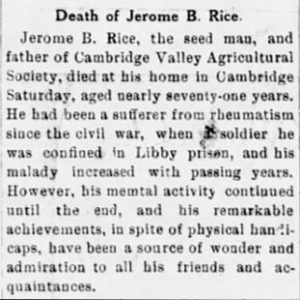
See The Rice Seed Company – Cambridge, NY for more historical photos and information.
Clipped below from the Bennington Banner (Bennington, VT) for August 30, 1895, a charming ad for J. B. Rice’s Great Fair at Cambridge, NY.
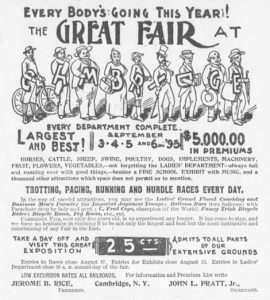
Sources: Gentilcore, David. (2010) Pomodoro!: A History of the Tomato in Italy. NewYork: Columbia University Press. (Google.com)
Memorial #37438546. Find A Grave. Find A Grave. http://www.findagrave.com/cgi-bin/fg.cgi.
Libby Prison. n.d. https://en.wikipedia.org/wiki/Libby_Prison (accessed June 2, 2018).
Zombek, Angela. M. Belle Isle Prison. Encyclopedia Virginia. (accessed June 2, 2018).
Kumar, Anne. “Couple restores historic Rice mansion.” October 24, 2004. Sunday, pp. C1, C8. (Newspapers.com).
Rice Mansion Inn. (www.ricemansioninn.com). Accessed June 2, 2018.
The Poultney Journal (Poultney, VT). June 14, 1912. Friday, p. 3. (Newspapers.com).
The Rice Seed Company – Cambridge, NY. (www.cambridgephoto.com). Accessed June 2, 2018.
“Every Body’s Going This Year!” Bennington Banner (Bennington, VT) August 30, 1895. Friday, p. 5. (Newspapers.com).

